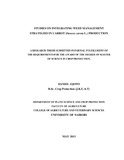| dc.description.abstract | Weed control constitutes one of the mam cost items and a constraint to carrot
production. The current study was conducted with the aim of developing an
integrated cost-effective strategy of managing weeds and increasing the competitive
ability of the crop against weeds. The weed control strategies tested in RCBD and
replicated three times; were black plastic mulch, grass mulch, herbicides (Linuron
and Oxyfluorfen), and grass mulch with herbicide combinations. Crop competitive
ability through application of foliar feed fertilizer with one hand weeding
combinations, foliar feed fertilizer with grass mulch combination, hand weeding
,every two weeks, famers practice (two hand weeding), and control (unweeded check)
were tested. Data was collected on weed species, weed density, weed control
efficiency, yield attributes, yield and economic cost benefits were subjected to
ANOVA and means separated by Duncan's multiple range test at P :S0.005. Efficacy
of weed control and carrot yield were significantly higher among the treatments with
black polythene achieving 99.6%, linuron 78.1% and famers practice 19.0 % weed
control resulting in yield of 34,205.5kglha, 30,356.7Kglha, 19,850kglha respectively.
The finding suggest that spraying linuron @ 2.0 l/ha as a pre-emergence is the best
for weed control to get higher yield and economic return than oxyfluorfen @ 1.0
kg/ha. It was concluded that plastic mulch is an effective strategy of reducing weed
growth in carrots.
Foliar feed application imparted competitive ability in carrot against weeds.
However, the foliar feed levels and. timing were not significant in imparting
competitive ability in carrots i.e. choosing between 41, 48 and 55 days after sowing
or their combinations. All the treatments increased marketable yield substantially
compared to unweeded check although yield varied marginally among the levels and
timings. However, there was a significant difference (P :s 0.05) in marketable yield
by Foliar feed application at 41, 48 and 55 days after sowing in combination with
hand weeding with yield of 24249 kg Iha compared to Foliar feed application at41,
48 and 55 days in combination with grass mulch yielding 21821 kg/ha. Application
of foliar feed increased tolerance in carrot against the effect of weed completion. For
example plots treated with foliar feed application 41, 48 and 55 days after sowing
• plus hand weeding once achieved 78.7 % weed control compared to unweeded check
which registered no weed control at all (0%).
Overall, plastic mulch treatment gave the best weed control, the highest plant weight
and marketable yield and yield attributes, resulting in the highest economic benefits.
The rest of the treatments had potential of weed control at various level of
effectiveness. It is, therefore, clear carrot production cannot be achieved without
successful weed management that involve technology that is affordable and
profitable to small scale farmers at the same time safeguarding the environment. The
carrot producers presumably will benefit from the best, economical and efficient
strategy in controlling weeds if the integrated weed management strategies are
adopted. | en |

